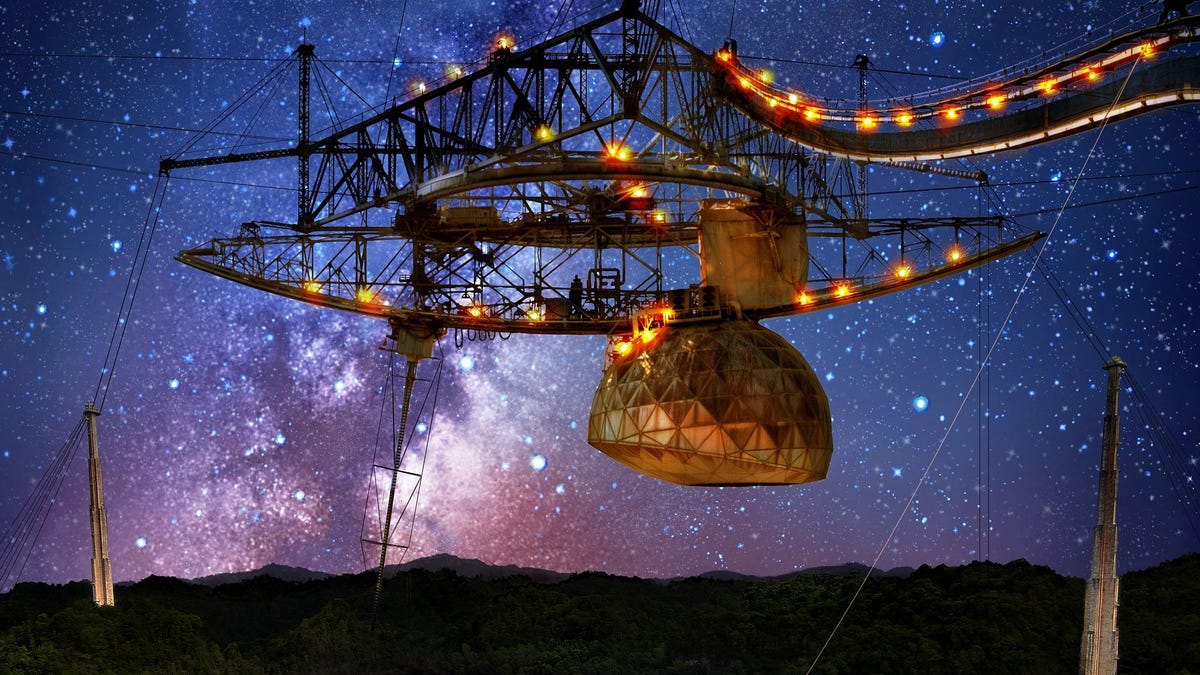Mysterious repeating deep-space signals have source in 'special' place
The bizarre "fast radio bursts" have only been observed repeating one other time. The new discovery is a major clue to the powerful sources behind the bursts.

The Arecibo radio telescope with an artist's rendition of a fast radio burst.
Astronomers look to be getting closer to solving one of the more recent and bizarre mysteries in the universe. For just the second time, scientists have picked up a strange radio signal from the other side of the cosmos called a "fast radio burst," or FRB, that repeats itself, making it possible to trace the very brief but powerful signal back to a source.
Dozens of FRBs have been detected so far, but until recently only one such signal -- named FRB 112102 -- was observed to repeat itself. A new Canadian radio telescope picked up a fresh batch of FRBs as it was beginning operations in the middle of 2018, including a new repeater that is clearly distinct from FRB 112102.
"They're in a completely different part of the sky and at least a billion parsec away from each other," Shriharsh Tendulkar told me. "We don't know the precise distance to the second one yet."
Tendulkar is a post-doctoral fellow at McGill university and member of the Canadian Hydrogen Intensity Mapping Experiment (CHIME) radio telescope team that made the new discovery, which will be presented Wednesday at the semi-annual American Astronomical Society meeting in Seattle and published in a pair of papers in the journal Nature.
"Until now, there was only one known repeating FRB. Knowing that there is another suggests that there could be more out there. And with more repeaters and more sources available for study, we may be able to understand these cosmic puzzles -- where they're from and what causes them," said Ingrid Stairs, another member of the CHIME collaboration and an astrophysicist at the University of British Columbia, in a statement.
One thing is different about the 13 new FRBs (including the new repeater called FRB 180814.J0422+73) discovered with CHIME: They were observed at lower frequencies than ever before (between 400 - 800 MHz).
The CHIME radio telescope in British Columbia.
"By detecting and characterizing fast radio bursts at different frequencies, we can understand better which theories work and which do not," Tendulkar said, adding that one potential source of FRB 112102 could be "a very strongly magnetized, rapidly spinning neutron star called a millisecond magnetar ... This model is promising but it's still too early to tell for sure."
A cosmic cataclysm in which the source destroys itself, like a neutron star collision or exploding black hole, can also be ruled out for the repeaters, he says.
Of course, super-advanced alien civilizations have been floated as possible explanations, including by Harvard University Professor Abraham Loeb.
"An artificial origin is worth contemplating and checking," Loeb said in 2017 while discussing his own theory that FRBs could conceivably be traced to massive energy beams used to propel alien starships. Loeb would later make waves in 2018 with another paper suggesting that interstellar object, Oumuamua, may have been such an alien probe.
The new FRBs from CHIME also show signs of "scattering," which is kind of like a record of the signals' interactions with electrons and magnetic fields as they traveled across the universe. This travel log, of sorts, also provides some clues as to possible sources, pointing to powerful astrophysical objects in locations with special characteristics.
"That could mean in some sort of dense clump like a supernova remnant," says team member Cherry Ng, an astronomer at the University of Toronto. "Or near the central black hole in a galaxy. But it has to be in some special place to give us all the scattering that we see."
It's still very early days in learning about FRBs and the special places they may come from, but as with the explosion in exoplanet discoveries and the nascent field of gravitational wave astronomy, each new detection provides a tantalizing new clue into the nature of the strange signals and to the universe itself.
NASA turns 60: The space agency has taken humanity farther than anyone else, and it has plans to go further.
Crowd Control: A crowdsourced science fiction novel written by CNET readers.

